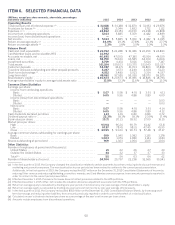American Express 2015 Annual Report Download - page 53
Download and view the complete annual report
Please find page 53 of the 2015 American Express annual report below. You can navigate through the pages in the report by either clicking on the pages listed below, or by using the keyword search tool below to find specific information within the annual report.
calculated under the advanced approaches may be lower than under the standardized approach. In such a case, we may
need to hold significantly more regulatory capital in order to maintain a given capital ratio.
There are several recent proposals or potential proposals that could significantly impact the regulatory capital
standards and requirements applicable to financial institutions such as the Company and our U.S. bank subsidiaries,
as well as our ability to meet these requirements. The Basel Committee has adopted a framework that would impose a
capital buffer on certain banks that may have an important impact on their domestic economies (so-called “domestic
systemically important banks,” or “D-SIBs”). Additionally, the Basel Committee has proposed a series of revisions to
the standardized approach for credit and operational risk capital requirements. If these or other proposals are adopted
in the United States and applied to advanced approaches institutions, we could be required to hold significantly more
capital.
For more information on capital adequacy requirements, see “Capital Adequacy” and “Liquidity Regulation” under
“Supervision and Regulation.”
We are subject to restrictions that limit our ability to pay dividends and repurchase our capital stock. Our
subsidiaries are also subject to restrictions that limit their ability to pay dividends to us, which may adversely
affect our liquidity.
We are limited in our ability to pay dividends and repurchase capital stock by our regulators who have broad
authority to prohibit any action that would be considered an unsafe or unsound banking practice. For example, we are
subject to a requirement to submit capital plans that include, among other things, projected dividend payments and
repurchases of capital stock to the Federal Reserve for review. As part of the capital planning and stress testing
process, our proposed capital actions are assessed against our ability to satisfy applicable capital requirements in the
event of a stressed market environment. If our capital plan is not approved for any reason or if we fail to satisfy
applicable capital requirements, our ability to undertake capital actions may be restricted. A failure to increase
dividends along with our competitors, or any reduction of, or elimination of, our common stock dividend or share
repurchase program would likely adversely affect the market price of our common stock and market perceptions of
American Express.
Our ability to declare or pay dividends on, or purchase, redeem or otherwise acquire, shares of our common stock
will be prohibited, subject to certain exceptions, in the event that we do not declare and pay in full dividends for the last
preceding dividend period of our Series B and Series C preferred stock.
American Express Company relies on dividends from its subsidiaries for liquidity, and federal and state law limit
the amount of dividends that our subsidiaries may pay to the parent company. In particular, our U.S. bank subsidiaries
are subject to various statutory and regulatory limitations on their declaration and payment of dividends. These
limitations may hinder our ability to access funds we may need to make payments on our obligations, make dividend
payments on outstanding American Express Company capital stock or otherwise achieve strategic objectives.
For more information on bank holding company and depository institution dividend restrictions, see “Dividends”
under “Supervision and Regulation,” as well as “Consolidated Capital Resources and Liquidity — Share Repurchases
and Dividends” under “MD&A” and Note 23 to our Consolidated Financial Statements.
Regulation in the areas of privacy, data protection and information security could increase our costs and affect
or limit our business opportunities and how we collect and/or use personal information.
As privacy, data protection and information security laws are interpreted and applied, compliance costs may
increase, particularly in the context of ensuring that adequate data protection and data transfer mechanisms are in
place. In recent years, there has been increasing regulatory enforcement and litigation activity in the areas of privacy,
data protection and information security in the United States and in various countries in which we operate.
In addition, legislators and/or regulators in the United States and other countries in which we operate are
increasingly adopting or revising privacy, data protection and information security laws that potentially could have
significant impact on our current and planned privacy, data protection and information security-related practices, our
collection, use, sharing, retention and safeguarding of consumer and/or employee information, and some of our
current or planned business activities. New legislation or regulation could increase our costs of compliance and
business operations and could reduce revenues from certain business initiatives. Moreover, the application of existing
or new laws to existing technology and practices can be uncertain and may lead to additional compliance risk and cost.
Compliance with current or future privacy, data protection and information security laws relating to customer
and/or employee data could result in higher compliance and technology costs and could restrict our ability to fully
maximize our closed-loop capability or provide certain products and services, which could materially and adversely
affect our profitability. Our failure to comply with privacy, data protection and information security laws could result in
potentially significant regulatory and/or governmental investigations and/or actions, litigation, fines, sanctions,
ongoing regulatory monitoring, customer attrition, decreases in the use or acceptance of our cards and damage to our
reputation and our brand.
42
























